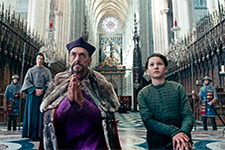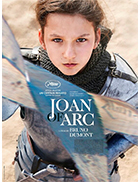Joan of Arc (Jeanne)
|  Bruno Dumont’s Joan of Arc (Jeanne) is an exceedingly odd retelling of the last two years in the titular medieval martyr’s life, when she successfully waged military campaigns against the English and was then captured by the Burgundians, tried for heresy, and burned at the stake. It is a sequel to Dumont’s 2017 film Jeannette: The Childhood of Joan of Arc (Jeannette, l'enfance de Jeanne d’Arc), which I have not seen. However, everything I have read suggests that Joan of Arc is similar in style and tone, which mixes arch theatricality with offbeat musical interludes, turning the film into a quasi-musical (the musical stylings are different this time, though—the first film featured heavy metal music, whereas this one features ethereal pop). Joan of Arc has been the subject of so many films at this point that one can’t blame Dumont for wanting to take the material in a new and unexpected direction; the problem, though, is that his self-conscious approach drains the film of emotional impact and spiritual depth, turning it into little more than stylized pageantry. The first half of the film takes place during Joan’s various military campaigns, starting after her miraculous victory at Battle of Orléans, although all battles remain conspicuously off-screen. Instead, Dumont, who wrote the screenplay from a revisionist play Charles Peguy, focuses on the interactions between Joan and various military officers as they discuss and debate strategies, risks, and rewards. Dumont stages these interactions for maximum theatrical distanciation, with Joan standing among sand dunes while various characters emerge from seemingly nowhere to engage in dry discussions that occasionally erupt into fiery dispute. Then Dumont stops the action cold for a lengthy musical interlude in which Joan stares at us through the screen in close-up. Dumont’s one conceit to action is a lengthy pageant in which soldiers on horseback go through an elaborate parade set to drumbeats, which Dumont shoots from extreme high angles that turns it into a riff on Busby Berkeley musicals. The second half of the film dramatizes Joan’s trial for heresy, which Dumont shoots beneath the imposing architecture of the Amiens Cathedral. Like Carl Theodor Dreyer did in The Passion of Joan of Arc (1928), the silent-era masterpiece against which all Joan of Arc films are invariably judged, Dumont relies heavily on the historical record, using the actual recorded exchanges between Joan and her accusers, who Dumont depicts as a preening group of insufferable, lisping hypocrites. Dumont actually spends a good deal of time with the judges before Joan arrives, to the point that we sit through a literal roll call. The ultimate point, though, is that they lack any honesty, integrity, or fundamental human decency, a point that is driven into the ground long before the trial winds its way to its preordained conclusion (Dumont’s one moment of visual genius is to show Joan’s fiery demise in a static long shot, which makes it oddly powerful in the way it makes us feel powerless in the face of tragedy and injustice). Dumont’s most radical artistic choice, though, was the casting of Lise Leplat Prudhomme as Joan. Prudhomme played the young Joan in Dumont’s previous film at the age of 8 (when Joan becomes a teenager, she is played by Jeanne Voisin). So, now that Joan is a young woman (she was 19 at the time of her trial and execution), Dumont has chosen to have her played by a 10-year-old. The effect of having a child playing a young adult is strangely inconsistent. At times Prudhomme’s open, youthful face contributes to a deeper sense of Joan’s mystery and spiritual fortitude, while at other times she simply seems out of her element and depth, as if she is playing dress-up on a grand scale. During the trial her youth accentuates the pedantic, paternalistic approach the judges took to Joan, who is depicted as their spiritual superior. Prudhomme’s performance is limited to a lot of stern looks, many of which she gives directly to the camera; at times it conveys the essence of Joan’s conviction, and at other times it looks like she simply has no other recourse. Dumont is certainly a challenging filmmaker, one who rarely if ever repeats himself and rarely takes the obvious or easy road. There is something to admire in his unorthodox approach, and at times it works. But, more often than not, it feels like he is doing something different simply for its own sake, which renders Joan of Arc mostly inert both dramatically and spiritually. Copyright © 2020 James Kendrick Thoughts? E-mail James Kendrick All images copyright © Kino Lorber |
Overall Rating: 
 (2)
(2)


